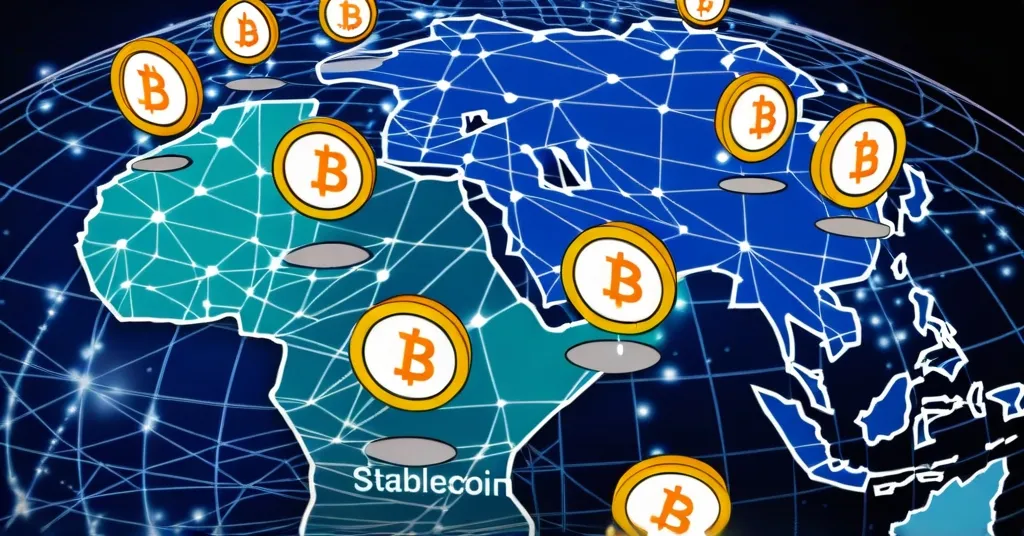Africa’s Blockchain Boom in 2024: Adoption Soars Amid Regulatory Challenges

Africa’s 2024 in Review: Adoption Unfazed, Regulatory Reckoning
In 2024, Africa’s digital asset and blockchain sector didn’t just grow—it exploded into a vibrant ecosystem, showcasing the continent’s readiness to lead in the global financial revolution. This year marked a significant shift towards practical use cases, demonstrating that Africa isn’t just following the trend but setting it.
- Adoption of blockchain and digital assets soared across Africa.
- Nigeria and South Africa lead in global adoption rates.
- Stablecoins dominate with over 40% of digital asset activity.
- Regulations crack down on unlicensed virtual asset service providers.
- 2025 promises more growth and regulatory maturity.
Blockchain and digital assets have surged in Africa, driven by the need for efficient financial solutions. The continent has seen a 200% increase in Telegram groups dedicated to digital assets, fueling this adoption. Nigeria and South Africa stand out as global leaders, with the Consensys Web3 Perception report and Chainalysis adoption index highlighting their dominance. This isn’t just about speculation; it’s about real-world applications. Cross-border payments and certificate verification are just the tip of the iceberg, with over 40% of digital asset activity involving stablecoins. These stablecoins, like USDT and USDC, have become the go-to for payments and transfers, offering stability in regions where traditional financial systems often falter.
National initiatives are also embracing this wave. The South African Reserve Bank’s digital payments roadmap includes stablecoins and tokenization as key priorities, recognizing their potential to revolutionize the financial landscape. Tokenization refers to the process of converting rights to an asset into a digital token on a blockchain. Meanwhile, Ghana and Nigeria are leveraging blockchain to combat corruption, showing that this technology isn’t just about money—it’s about governance and transparency.
Yet, with growth comes scrutiny. Nigeria’s Economic and Financial Crimes Commission (EFCC) has taken a hard stance against unlicensed offshore exchanges, accusing them of economic sabotage. The case against Binance, where over $35 million in alleged laundering was involved, underscores the tension between innovation and regulation. South Africa, on the other hand, has taken a more permissive approach, issuing numerous Virtual Asset Service Provider (VASP) licenses to foster a regulated environment. VASP stands for Virtual Asset Service Provider, which is a business that deals with digital assets.
As Africa’s blockchain and digital asset sector continues to evolve, it’s not without its challenges. Infrastructure limitations and security concerns remain hurdles, yet the continent’s resilience and innovation continue to push forward. Africa isn’t just joining the blockchain party; it’s bringing its own DJ and turning it into a festival.
Looking ahead to 2025, the future looks bright but challenging. The sector is expected to grow, with more regulated VASPs and continued education driving adoption. However, the regulatory landscape will need to balance fostering innovation with protecting consumers. Africa’s blockchain and digital asset sector isn’t just a trend; it’s a testament to the continent’s potential to shape the future of finance.
Here are some key takeaways and questions to ponder:
- What has driven the growth of Africa’s digital asset and blockchain sector in 2024?The growth has been driven by robust adoption focusing on practical use cases, such as cross-border payments and certificate verification, alongside increased regulatory attention.
- Which countries in Africa are leading in digital asset adoption?Nigeria and South Africa are identified as global leaders in digital asset adoption.
- What role have stablecoins played in Africa’s digital asset landscape?Stablecoins have become the most popular digital asset in Africa, accounting for over 40% of activity, primarily used for payments and cross-border transfers due to their stability.
- What regulatory actions were taken against virtual asset service providers in Africa during 2024?Nigeria cracked down on unlicensed offshore exchanges, while South Africa issued numerous VASP licenses to regulate the sector.
- What is expected for Africa’s digital asset and blockchain sector in 2025?The sector is expected to grow with more regulated VASPs and continued education initiatives driving adoption, positioning Africa for its best year yet.
“Africa has often been cited as the next frontier for digital asset adoption. However, in 2024, the region proved that its time is now.”
“The Consensys Web3 Perception report in December identified Nigeria and South Africa as the two global leaders in digital asset adoption.”
“This adoption is making its way into national initiatives. Earlier this year, the South African Reserve Bank published its digital payments roadmap, citing stablecoins and tokenization as some of the key priorities.”
“The watchdog accused the exchange of helping users launder over $35 million, a case still ongoing amid a scandal involving the arrest and eventual release of Binance executive Tigran Gambaryan.”
“As we head into 2025, Africa’s digital asset and blockchain sector is poised for what could be its best year yet.”



